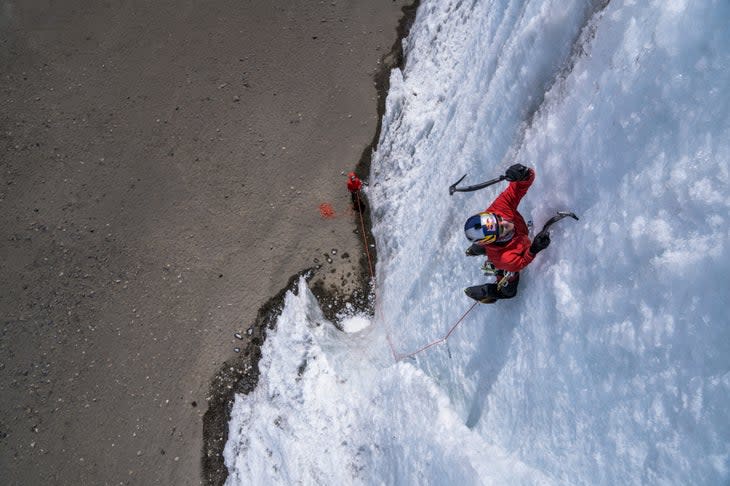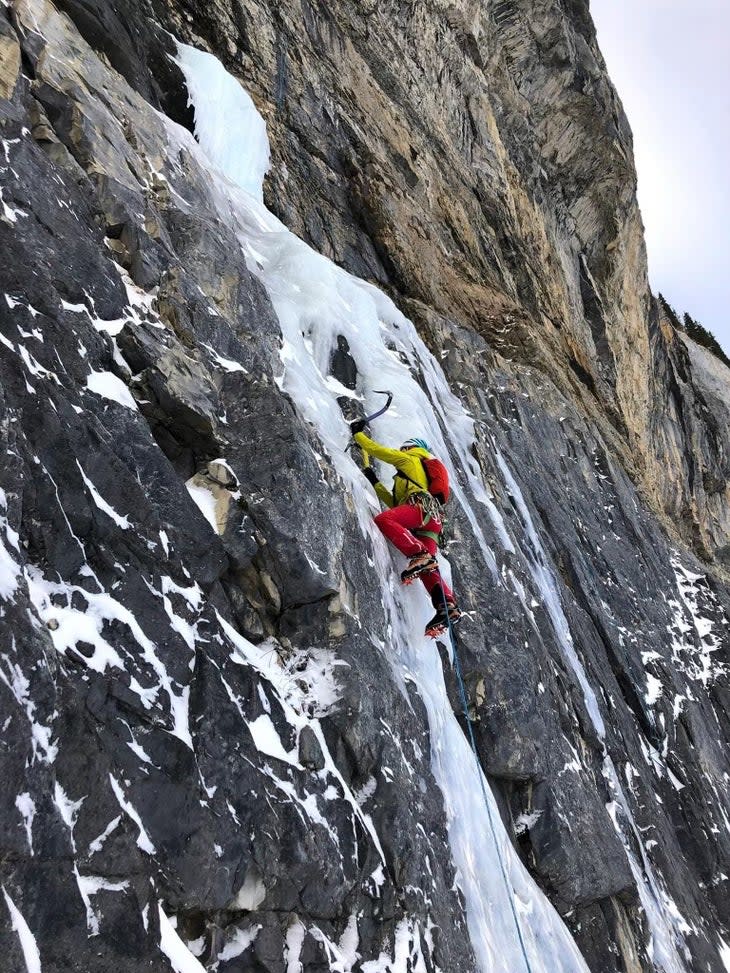Are You Ready to Lead Ice?
This article originally appeared on Climbing
Lead falls are an indispensable part of rock climbing. Ask any performance-oriented sport or trad climber and they'll tell you: become comfortable with big, safe falls if you want to reach your full climbing potential. But as autumn turns to winter, and climbing rock outdoors sounds too painful to be fun, many experienced rock jocks will try out ice climbing--and will be eager to continue pushing themselves. In ice climbing, though, be warned: the falls are rarely clean and often dangerous.
“You’ve got about 50 percent odds of injuring or killing yourself if you fall off,” says Canadian pro ice climber, Will Gadd. Gadd has spent the last three decades climbing ice around the world, winning ice competitions, and teaching newcomers to the sport how not to break their legs.
With such high consequences, leading ice is not for the faint of heart. But most folks want to be on the sharp end, so how do newer ice climbers know when it is time to grab the screws?

Top rope, top rope, top rope
According to Gadd, who has advocated for newbies to top rope 100 pitches of ice before their first lead, this large, arbitrary number is merely a guideline. Do anything a hundred times and you will gain a basic understanding of it. "[But] it won’t make you a good ice climber,” he warns.
When stacking up your 100 pitches, keep in mind that not all top-rope laps are created equal. In Ouray, for example, heavily trafficked lines can be so picked out that there are steps for your feet. This is worlds apart from a fresh backcountry line in Cody, Wyoming, where you have to swing many more times to get a good stick.
Practice in variable conditions
Tim Farr, an AMGA-certified ice guide, emphasizes the importance of top roping in variable conditions. “Really climb as [many] different styles of ice as you can,” he said. “Climb in different temperatures too. Sunny, warm ice in 30-degree temperatures acts a lot differently than ten below [with] a strong, stiff wind in the shade. Protection is going to be different, swinging into things is going to be different, [the ice is] going to break a lot more.”
Top roping in variable conditions will also allow you to safely push your limits--a skill which Gadd can't recommend enough. The more you understand how ice behaves in the more extreme conditions--be it very thin, chandeliered, or brittle--the better equipped you will be to lead it safely.
“If you don’t develop an understanding of the limits in a safe environment then you’re not going to understand them while actually leading,” says Gadd. “You gotta know where the limits are to know how close you are to them. Most people don’t.”
Beware of overconfidence

Perhaps the most dangerous part of ice climbing is when new leaders feel relaxed and confident, wholly unaware that their tools are about to pop out. Lauren Shartell, a member of the USA ice-climbing team, notes that an ice climber with little experience could probably lead an ice route just fine, but also “the nature of ice climbing is that everything is fine until it’s not.” She says, “as a beginner I think a lot of risk lies in overestimating our abilities.”
According to Shartell, it is reasonable to start leading when you understand what a secure tool placement is, how moving off of it can alter its strength, and how and where to swing your tools. Shartell says top-rope mileage is most important before taking the lead, including placing many ice screws in a mock-lead environment.
When to start leading
Still not sure if you are ready to take the sharp end? According to Gadd, if you can comfortably climb up and down a pitch of ice, you are probably ready to lead it. Or, if you can do multiple laps on fresh, vertical ice, it's also in your wheelhouse. He even has a metric to gauge if a climb is out of your paygrade (though it only works in hindsight): if it takes you more than 30 minutes to lead a pitch of straightforward ice in good conditions, then maybe you should lead easier pitches or get more mileage on top rope. But, "if it's completely wacko ice climbing, [taking more than 30 minutes] okay," he adds.
Other signs are more telling. Industrial-standard sticks (ISS) are essential for leading, as is good balance and feeling relaxed. What the hell are ISS, you ask? By Gadd's definition, it's a tool placement so solid “it would take an earthquake to yank you off.”
Rock-climbing skills don’t always translate
If you are coming from a rock-climbing background, it is tempting to think that your ice tool is a jug. And if you can hold on to a jug for a long time--as strong rock climbers can--then maybe you can lead ice without much experience. But Gadd says this is an unfortunately common, and grave, error.
“In ice climbing, the ice tool is not the hold. The ice is the hold.... And until rock climbers figure that out they tend to do things like grab their tools too high,” he says. Choking up too high on the tool can turn a good placement into a poor one, altering the direction of pull, and just begs to blow.
[Related: Watch a big leader fall when an ice climber chokes up on his tool.]
Until rock climbers learn the importance of directional tool placements--pulling down, not out or right or left--Gadd says it's important to stay off the sharp end. “No rock climber who hasn’t done a lot of ice climbing has any understanding of ice,” says Gadd. “It’s honestly horrifying to watch a lot of people lead. They have no idea how close they are to falling off a lot of the time.”
Understanding how ice behaves underneath our tools takes time. Ice is so complex, in fact, that Gadd says he learns something new every single time he goes out--and he has been leading for 35 years.

Keely Dickes is a writer based in Glenwood Springs, CO. When she's not writing, she can be found working a project at Rifle, trail running in the mountains, or having an IPA with her friends.
For exclusive access to all of our fitness, gear, adventure, and travel stories, plus discounts on trips, events, and gear, sign up for Outside+ today.


